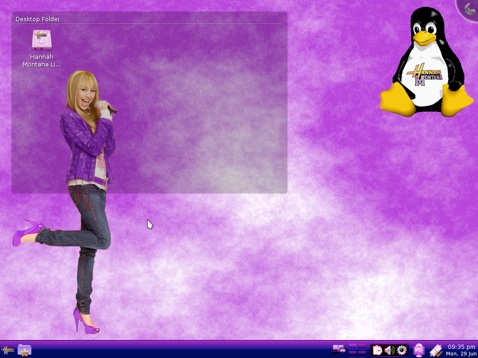Who's a candidate for Desktop Linux? Your Kids.


"Hannah Montana Linux" may not be ready to give to your kids yet, but it's an idea that has legs.
My partner in crime in the Frugal Tech Show, Ken Hess, who blogs over at Daniweb, recently published his list of Top 10 Linux Distributions for 2009. His readers gave him a lot of feedback due to the exclusion of some of their favorites, so he published a second piece, a "Reader's Choice" list of their Top 10 based on their submissions.
One of the distributions on that list that caught my eye was "Hannah Montana Linux". No, I'm not joking.
Click on the "Read the rest of this entry" link below for more.
"Hannah Montana Linux" is little more than a desktop theme applied to fairly out-of-the box Kubuntu, running KDE 4.x. It's not approved by Disney or Miley Cyrus, it's simply just the efforts of a single programmer, who thought it might be a good idea to attract children to Linux.
Now, others who actually work with kids or are professional educators know a lot more about deploying Linux to children than I do, like our own Education IT blogger, Christopher Dawson, who's written about the topic extensively.
However, I do know a little bit about what's at stake. Deploying Linux in an educational environment has a lot of considerations and pitfalls, particularly as it pertains to controls and how the software would be integrated into a curriculum. Efforts such as OLPC and the Intel Classmate running various Linux variants have been put into various trials all over the world, some more successful than others.
In my "Who is a Candidate for Desktop Linux"column I addressed certain usage scenarios that might make someone a good target to use Linux. One of those groups I identified was "The Super-Casual Web Surfer".
While I initially suggested that Senior Citizens or netbook users might represent a large portion of this group, it now occurs to me that children under the age of 13 might also fit into this classification, but with the caveat that unlike Seniors or other adult casual surfers, they require supervision when browsing the Internet and making choices about which applications and sites they use. For parents, the Internet is a big scary ocean for their children to be swimming in, rife with predators and all sorts of awful things that they don't want them to be exposed to.
"Hannah Montana Linux" as it is currently deployed -- vanilla Ubuntu or Kubuntu Linux with a fun theme pack of your child's choosing -- would not be an appropriate choice to give to very young kids and allow them to use unsupervised. While spyware and viruses would not be a concern, you'd still have to add some sort of content-filtering service, such as ContentWatch, to block out anything that you don't want your kids to see.
What I envision as a product is essentially a Live CD or light virtual machine (via VMWare Player or other mechanism that would lock children into a "sandboxed" environment) that you can run on any PC or Mac that when combined with content filtering technology, such as via a special proxy service via a SAAS application, that would allow parents to control exactly what they want their kids to be able to see.
Ideally, this product would be driven by educators and child-rearing experts that would know how to set "thresholds" of what is permissible to certain age groups. For example, it might be OK for a 10 year old to watch giant robots blast lasers at each other on the Transformers web site, but it might not be good for a 5-year old. All a parent would need to do is log into their SAAS account for the content filtering system, set the child's age group or any other desired filtering criteria, and then those policies would be applied to the virtual system, netbook, or whatever device the child is using.
Linux in a Virtual Machine, Live CD or child-hardened netbook such as a Classmate, running a cloud-managed content system is an ideal environment because it could run on any PC OS, Windows or Mac, and because it would be sandboxed, would not interfere with the operations of the host OS.
The product as envisioned would just be an icon that the parent could click on and be set with a strong password that would prevent the child from leaving the constraints of the sandboxed environment. It could also be integrated and embedded into any number of set-top devices for hooking up to a television, or ran as as a piece of game software for PS3 or XBOX.
Would a content-filtered, Linux-based virtual appliance for children give you some piece of mind? Talk Back and Let Me Know.